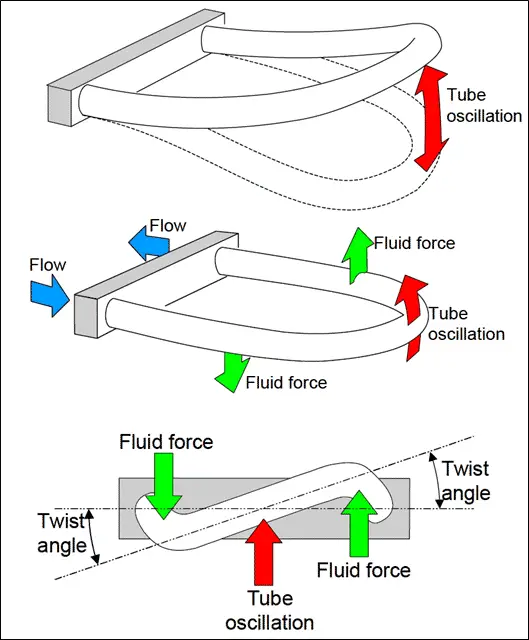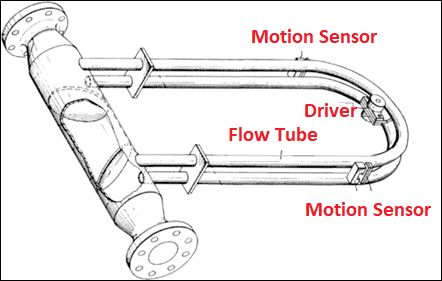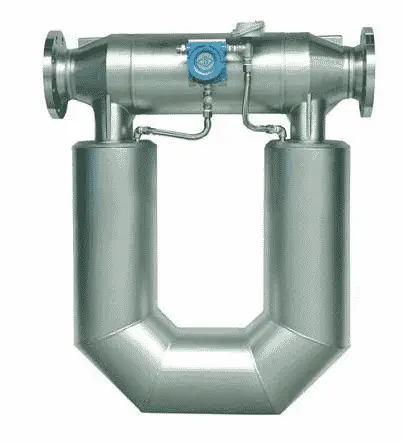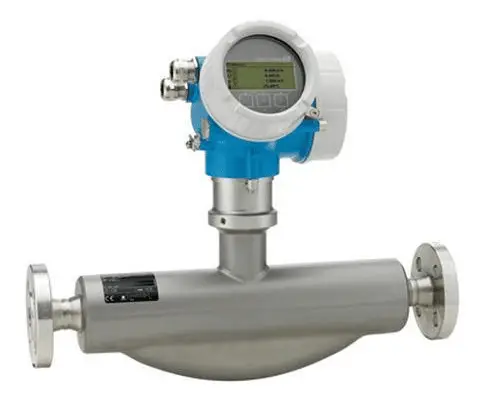Coriolis mass flow meter working principle is based on the Coriolis Effect. The Coriolis force is the forces of inertia that affect tube oscillations. For example, the garden hosepipe wriggles and has a serpentine motion when water flows through it.
Coriolis Mass flow meters find wide applications in industries to accurately calculate the flow while transferring material. The Coriolis and thermal mass flow meters are well-known mass flow meters. Coriolis mass flow meter is most popular because we can use Coriolis mass flow meter in almost all the applications.
Working Principle of Coriolis Mass Flow Meter
Coriolis mass flow meter got its name from the Coriolis Effect because it works on this principle.

The Coriolis mass flow meter uses a very basic motion mechanic principle i.e. Coriolis Effect. Suppose, a tube is continuously oscillating at a fixed oscillation. The fixed oscillation is the resonant frequency. The resonant frequency depends on the stiffness and mass of the tube. The vibrating coil creates oscillations. The other name of the vibrating coil is oscillating coil.
When any fluid passes through this tube, the flow or say velocity of the fluid passing will deform the tube’s structure (twisting effect) in opposite direction at the inlet and outlet of the tube. The fluid flow will also have an impact on the oscillations of the tube which is already oscillating at a fixed frequency. This flowing fluid creates a phase shift on the oscillating tube which is calibrated to know the flow of the fluid.
This change in phase is change in pickup signal in terms of time. The original time when no fluid was passing and new time when fluid is passing) observed in an oscillating tube when fluid is passed through the tube is Coriolis Effect.
Working of Coriolis Mass Flow Meter

Coriolis mass flow meter has 2 tubes oscillating at their resonant frequency using a driver coil. Whenever flow passes through these tubes, we observe a change in the oscillations of these 2 oscillating tubes.
Both ends of the tube inside a Coriolis mass flow meter consist two motion or pick-up sensors. These motion sensors captures the oscillations. Thus, the oscillating tubes will have a phase shift according to the fluid flow, and the Coriolis mass flow meter is calibrated to show the fluid flow based on the phase of the oscillating tubes.
Also 1 very important parameter which we can know from Coriolis mass flow meter is the Density of the fluid flowing through the tubes. Because of this density measurement functionality, we can also know the volumetric flow passing through our Coriolis mass flow meter.
The change in the frequency of the vibrating tube gives us the density of the fluid passing through the tube. Because density changes with change in temperature, an internal temperature sensor are also provided in Coriolis mass flow meter for the compensation of changes in temperature to get an accurate density of the fluid flowing through the tubes.
The whole assembly is inside a special housing for protection against environmental effects.


Main Features
- A Coriolis meter is suitable for a variety of applications ranging from adhesives and coatings to liquid nitrogen.
- Typical measuring range of curved tube-designed Coriolis meters vary between 100:1 and 200:1. The measurability of straight-tube meters is limited and it ranges between 30:1 and 50:1. Also, the accuracy of straight tube meters is low.
- In the case of Coriolis meters, the measurement does not affect temperature, pressure, viscosity, and density. Hence, no compensation is needed.
- They are particularly more suitable for handling those liquids whose viscosity changes with velocity while temperature and pressure remain constant.
- Coriolis meters are capable to measure nearly all liquids, slurries, and gases. They can also measure all liquid flows such as Newtonian, non-Newtonian, and moderately dense gases as well. That is why these are called universal meters.
- We can use these meters to measure liquid density as well.
- There is no restriction of Reynolds number with Coriolis flow meters.
- Their performance does not affect by changes in the velocity profile.
Advantages of Coriolis Mass Flow Meter
The followings are the advantages of the Coriolis mass flow meter.
- Coriolis mass flow meter can measure a wide range of fluid flow because this flow measurement technique is independent of the viscosity of the fluid flowing and hence least and most viscous fluid flow can be measured through Coriolis mass flow meter.
- They can measure both, mass flow as well as a volumetric flow which is its unique advantage. It can also measure temperature and fluid density too.
- They can measure fluid flow as low as a few grams per hour up to 3265000 kilograms per hour.
- The Coriolis mass flow meters have very high accuracy compared to other flow meters. The accuracy of the Coriolis mass flow meter is 0.1%.
- Coriolis mass flow meters do not have any specific requirement of flow properties. Coriolis mass flow meter works for laminar as well as turbulent flow also.
- From the construction, it is very clear that Coriolis mass flow meters can work for slurry services also and will not create any drop in pressure which most flow meters do create.
- Coriolis mass flow meters have no internal moving parts installed in tubes or pipe which come in contact with the flowing fluid, this reduces maintenance of the flow meter.
- The Coriolis mass flow meter can be used to detect the fluid flow in both directions. The only polarity of the flow changes i.e. in forwarding fluid flow condition, the flow will be +(value) kilogram per hour and in reverse fluid flow condition, the flow will be -(value) kilogram per hour.
- Coriolis mass flow meters do not require any inlet and outlet straight runs in pipes.
Disadvantages of Coriolis Mass Flow Meter
- Coriolis mass flow meters are a bit expensive compared to other mass flow meters, but the dual functionality of measuring mass flow as well as volumetric flow brings its price worthy.
- Coriolis mass flow meter requires vibration less pipe i.e. if installed in the pipe which is already vibrating, then flow readings will be inaccurate.
- Troubleshooting Coriolis mass flow meter requires a highly skilled person.
- Coriolis flow meters do not work efficiently for a flow rate of low-pressure gas. Low-pressure gases have low density, and their mass flow rate is usually very low. Application with pressure less than 150 psig is marginal with the flow meter designs that are currently available.
- Coriolis flow meters are not available for large pipelines. For measuring large flow rates, two or more flow meters in parallel need to be installed. The largest Coriolis flow meter currently available has a maximum flow rating of 25,000 lb/min (11,340 kg/min).
Read Next: